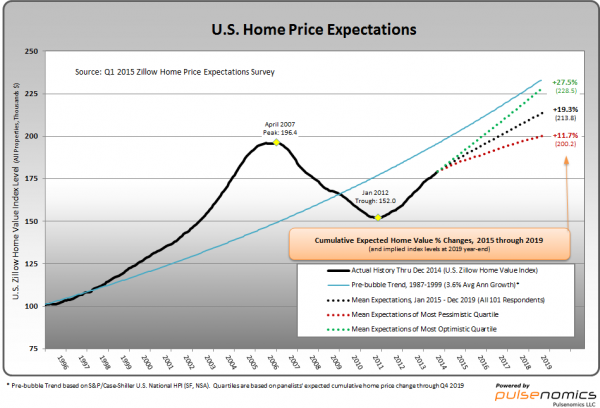On February 13, 2015, the Zillow Q1 2015 Home Price Expectations Survey results were released. This survey is done on a quarterly basis.
An excerpt from the Press Release:
The panelists predicted U.S. home values will rise 4.4 percent in 2015, to a median value of $187,040. The most optimistic forecasted a 5.5 percent increase, while the least optimistic projected a 3.1 percent increase. On average, panelists said they expect median U.S. home values to exceed their pre-recession peak of $196,400 by May 2017.
“During the past year, expectations for annual home value appreciation over the long run have remained flat, despite lower mortgage rates,” said Terry Loebs, Founder of Pulsenomics. “Regarding the near-term outlook, there is a clear consensus among the experts that the positive momentum in U.S. home prices will continue to slow this year. At 4.4 percent, overall expectations for nationwide home value growth in 2015 are one-third lower than the actual 6.6 percent appreciation rate recorded last year.”
–
Various Q1 2015 Zillow Home Price Expectations Survey charts are available, including that seen below:
As one can see from the above chart, the average expectation is that the residential real estate market, as depicted by the U.S. Zillow Home Value Index, will continually climb.
The detail of the Q1 2015 Home Price Expectations Survey (pdf) is interesting. Of the 101 survey respondents, only one (of the displayed responses) forecasts a cumulative price decrease through 2019; and even that one does not foresee a double-digit percentage cumulative price drop. That forecast is from Mark Hanson, which foresees a 7.55% cumulative price decrease through 2019.
The Median Cumulative Home Price Appreciation for years 2015-2019 is seen as 4.50%, 8.16%, 12.04%, 15.07%, 18.75%, respectively.
For a variety of reasons, I continue to believe that even the most “bearish” of these forecasts (as seen in Mark Hanson’s above-referenced forecast) will prove too optimistic in hindsight. From a longer-term historical perspective, such a decline is very mild in light of the wild excesses that occurred over the “bubble” years.
I have written extensively about the residential real estate situation. For a variety of reasons, it is exceedingly complex. While many people continue to have an optimistic view regarding future residential real estate prices, in my opinion such a view is unsupported on an “all things considered” basis. Furthermore, from these price levels there exists outsized potential for a price decline of severe magnitude, unfortunately. I discussed this downside, based upon historical price activity, in the October 24, 2010 post titled “What’s Ahead For The Housing Market – A Look At The Charts.”
_____
The Special Note summarizes my overall thoughts about our economic situation
SPX at 2096.99 as this post is written
